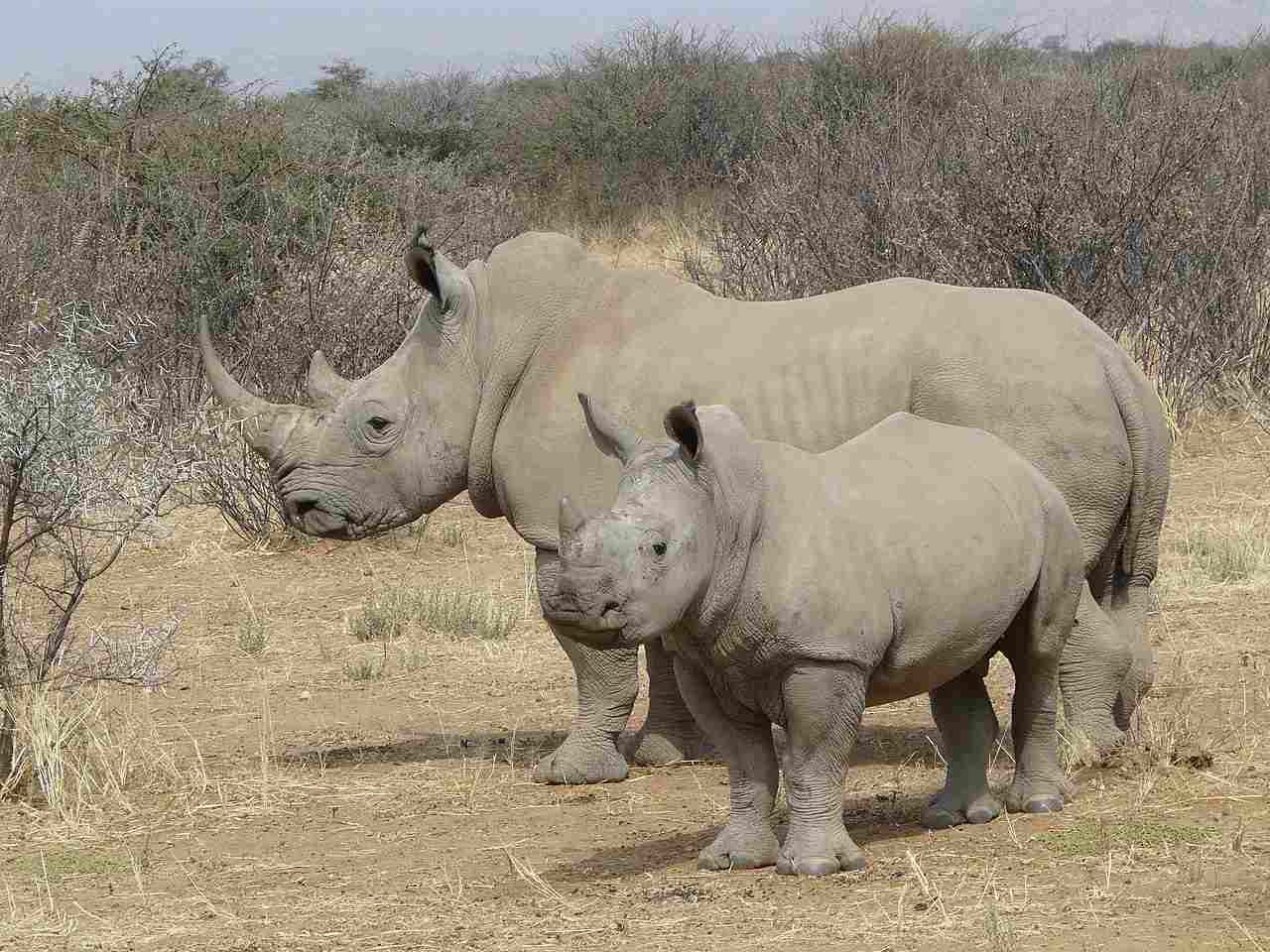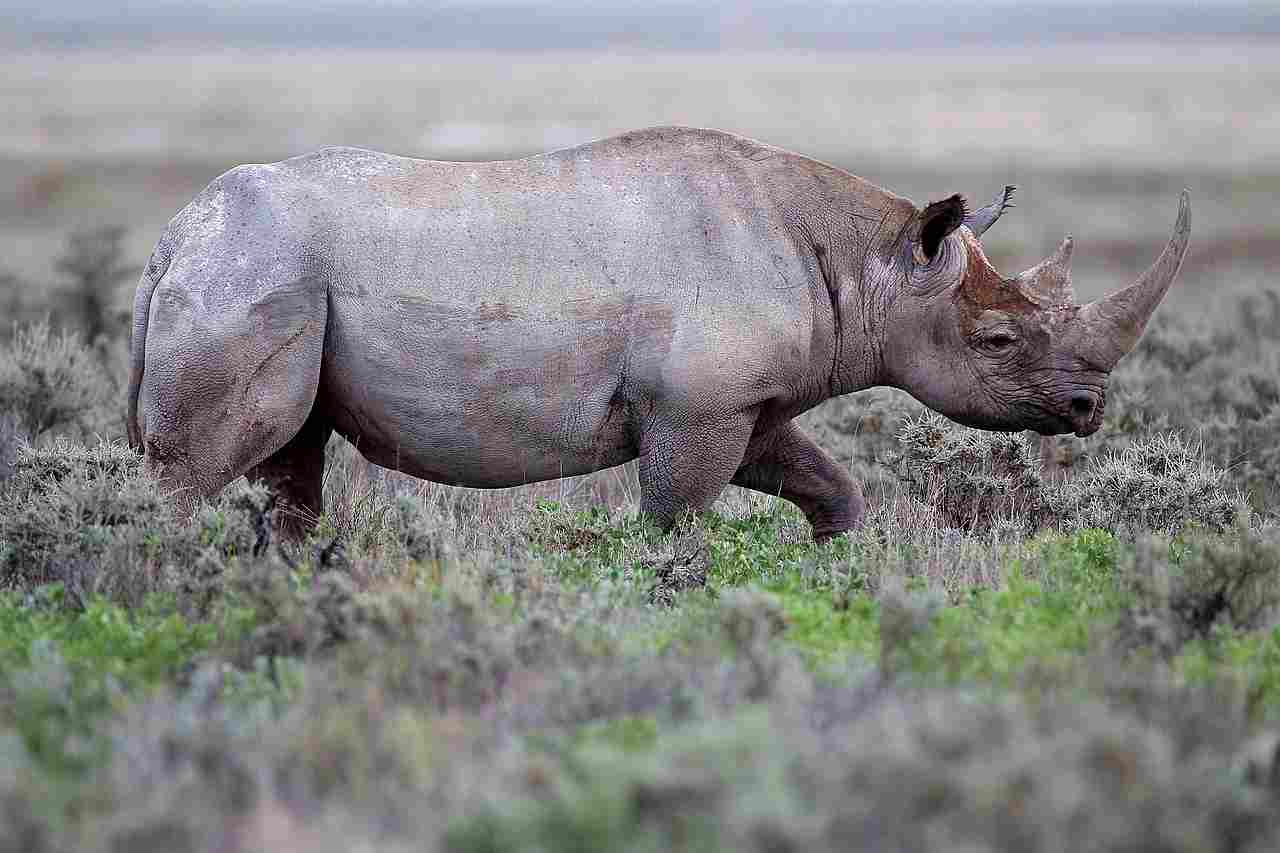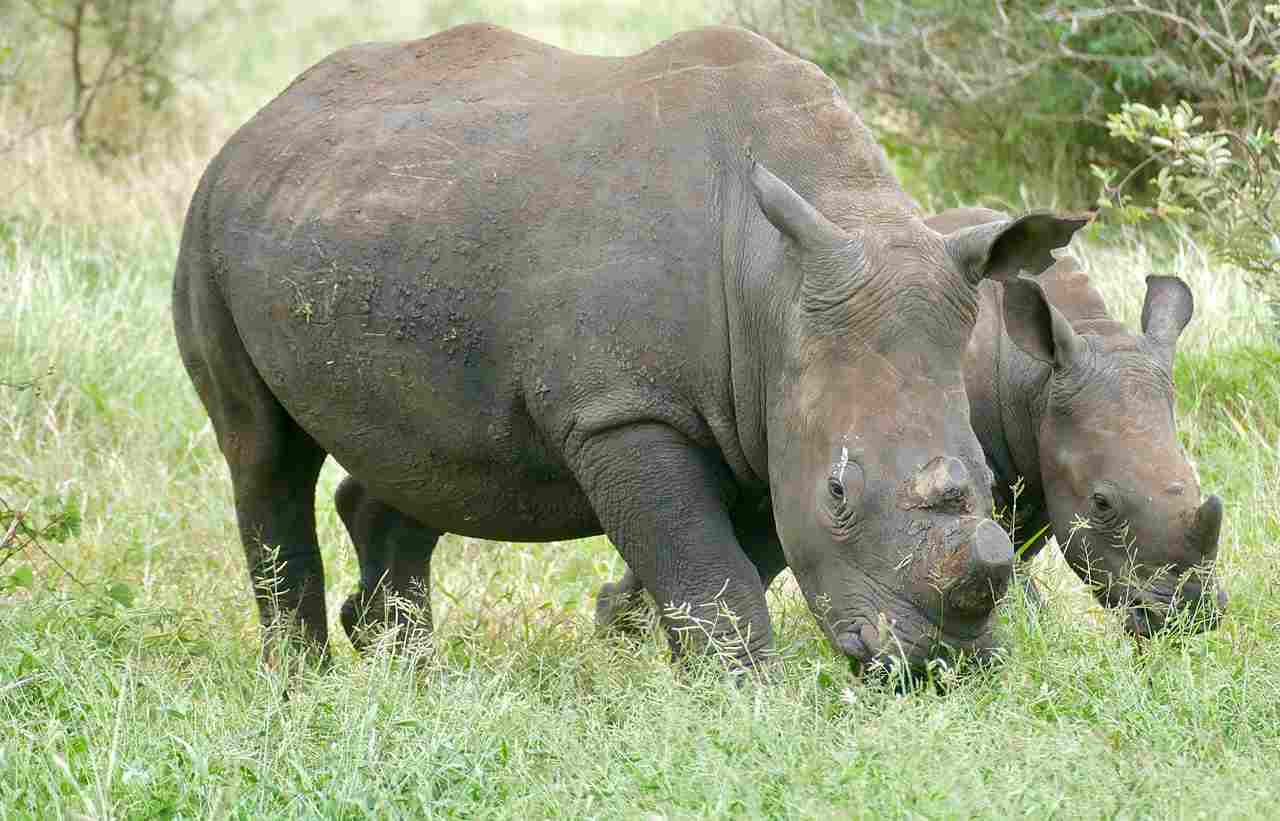White Rhino Vs Black Rhino Size, Weight, Ecological Comparison
White rhinos will likely overpower and defeat black rhinos in a violent confrontation, due to their superior strength, size and weight (on average).
Various factors can be used to compare these animals, as shown in this article. When it comes to taxonomy, the white rhino and black rhino belong to the same family but different species. In terms of appearance, the white rhino has a square-shaped mouth, while the black rhino has a hooked lip.
Size and weight comparisons reveal that the white rhino is larger and heavier than the black rhino. These differences in physical characteristics contribute to variations in their overall physical capacity and behavior.
Key Outcomes
*Biological Comparison
The White Rhino and Black Rhino are both members of the same biological family, Rhinocerotidae, but they belong to different genera and species. The White Rhino, scientifically known as Ceratotherium simum, and the Black Rhino, known as Diceros bicornis, have distinct characteristics that set them apart.
*Size and Weight Comparison
The size and weight of the White Rhino and Black Rhino are significant factors that differentiate them. When comparing their sizes, it is important to note that the White Rhino is generally larger than the Black Rhino. The White Rhino can reach a height of up to 6 feet at the shoulder, while the Black Rhino stands at around 4 to 5 feet. Additionally, the White Rhino can measure up to 12 to 13 feet in length, whereas the Black Rhino is slightly shorter, measuring around 10 to 11 feet.
In terms of weight, the White Rhino also surpasses the Black Rhino. The White Rhino can weigh anywhere between 4,000 to 6,000 pounds, making it one of the largest land mammals. On the other hand, the Black Rhino weighs significantly less, ranging from 1,800 to 3,100 pounds.
This difference in size and weight is attributed to their distinct ecological adaptations and feeding habits. The White Rhino is a grazer, primarily feeding on grass, which requires a larger body size to support its dietary needs. On the other hand, the Black Rhino is a browser, feeding on leaves and twigs, which allows it to maintain a smaller body size.
*Physical Capability Comparison
On average, white rhinos are stronger, heavier and larger than black rhinos.
However, it must be noted that their physical capabilities, such as bite force and overall strength, vary based on their ecological adaptations and behaviors, and can differ significantly from one individual to another.
1). Taxonomy
The taxonomy of the white rhino and black rhino is an important aspect to consider when comparing these two species. Both rhinos belong to the same genus, Ceratotherium, but they are different species. The white rhino is scientifically known as Ceratotherium simum, while the black rhino is known as Diceros bicornis.
When comparing the taxonomy of these animals, it is evident that they are closely related, but they have distinct characteristics that set them apart. The white rhino is characterized by its square-shaped lip, which is adapted for grazing on grass. On the other hand, the black rhino has a prehensile lip, which allows it to browse on leaves and twigs.
2). Appearance
The appearance of the white rhino and black rhino is distinct and can be observed through their coat, fur, and skin. The white rhino has a grayish-brown coloration, which helps it blend in with its grassland habitat. Its skin is thick and armored, providing protection against potential threats. In contrast, the black rhino has a darker coloration, ranging from brown to black, allowing it to camouflage effectively in its forested surroundings. Its skin is also thick but has a rougher texture.
In terms of stature and build, the white rhino is larger and bulkier compared to the black rhino. It has a more robust appearance, with a wide and square-shaped body. On the other hand, the black rhino has a more compact and agile build, with a narrower body and a slightly hunched back.
When comparing the appearance of these two rhino species, it is evident that their physical characteristics are adapted to their respective habitats. The white rhino’s larger size and grayish-brown coloration make it well-suited for the open grasslands, while the black rhino’s smaller build and darker coloration allow it to navigate through dense vegetation
3). Size
The size of the white rhino and black rhino can be compared by looking at their total body length and height at the shoulders. The white rhino is known to be the larger of the two species, with an average total body length ranging from 11 to 13 feet and a height at the shoulders of around 5 to 6 feet. On the other hand, the black rhino is slightly smaller, with an average total body length of 10 to 11 feet and a height at the shoulders of about 4.5 to 5.5 feet.
This difference in size is reflective of their respective habitats and feeding behaviors. The larger size of the white rhino allows it to graze on grasses in open grassland areas, where it needs to cover more ground to find sufficient food. In contrast, the black rhino’s smaller size is better suited for navigating through dense vegetation in forested areas, where it feeds on leaves, shoots, and branches.
While the white rhino’s larger size may provide it with certain advantages in terms of dominance and defense against predators, the black rhino’s smaller size and agility allow it to maneuver more easily in its environment.

4). Weight
When comparing the white rhino and black rhino, their weight is an important factor to consider. The white rhino is the heavier of the two species, with an average weight ranging from 4,000 to 6,000 pounds. In contrast, the black rhino is slightly lighter, weighing between 2,000 and 3,000 pounds on average.
The difference in weight is influenced by various factors, including their feeding habits and body structure. The white rhino’s larger size and grazing behavior require it to consume a larger quantity of grass, resulting in a higher weight. On the other hand, the black rhino’s smaller size and browsing behavior, where it feeds on leaves and branches, contribute to its relatively lighter weight.
5). Bite Force
The bite force of an animal is a crucial factor in determining its predatory capabilities and overall physical strength. When comparing the white rhino and black rhino, their bite forces differ significantly.
The white rhino possesses a formidable bite force, which allows it to exert immense pressure when biting down. This powerful bite force enables the white rhino to efficiently graze on grass, its primary source of food. With its wide, square-shaped lips and strong jaw muscles, the white rhino can easily tear through tough vegetation, exerting a bite force of up to 2,000 pounds per square inch (psi).
In contrast, the black rhino has a relatively weaker bite force compared to white rhinos. The black rhino’s bite force is estimated to be around 1,000 psi, which is still considerable but not as powerful as the white rhino. This difference in bite force is attributed to the black rhino’s browsing behavior, where it primarily feeds on leaves and branches rather than grass.
6). Overall Physical Capacity
When comparing the overall physical capacity of the white rhino and black rhino, several factors come into play. These factors determine which of the two species is stronger and what would happen in the event of a violent confrontation.
One important aspect to consider is their size and weight. The white rhino is the larger of the two, with males weighing up to 5,000 pounds and females reaching around 3,500 pounds. In contrast, black rhinos are smaller, with males weighing up to 3,000 pounds and females averaging around 2,000 pounds. This size advantage gives the white rhino a greater physical presence and potentially more power in a confrontation.
Another factor to consider is their behavior. White rhinos are generally more docile and peaceful, preferring to graze on grass and avoid conflict. On the other hand, black rhinos are known to be more aggressive and territorial (than white rhinos), often engaging in confrontations with other animals, including their own kind. This aggressive behavior could give the black rhino an advantage in a violent encounter.
Additionally, the white rhino’s powerful bite force, as mentioned in the previous section, contributes to its overall physical capacity. With a bite force of up to 2,000 psi, the white rhino has the ability to exert immense pressure and cause significant damage if necessary.
7). Habitat
The white rhino is primarily found in grassland and savannah habitats, where there is an abundance of grass for grazing. They are well-adapted to these open areas and can often be seen in groups, known as crashes, peacefully grazing on the grass. This habitat provides them with ample food resources and allows for social interactions within their groups.
On the other hand, the black rhino is more adaptable and can be found in a wider range of habitats, including grasslands, woodlands, and even deserts. They are known to be more solitary animals, preferring to roam and forage alone. This habitat flexibility allows them to survive in different environments and find food sources that suit their needs.
When comparing the two species, it is clear that the white rhino has a more specific habitat preference, while the black rhino is more adaptable. This difference in habitat preference may be attributed to their feeding habits and social behaviors.
8). Lifespan
When comparing the white rhino and the black rhino, one important aspect to consider is their lifespan. The lifespan of an animal can provide insights into its overall health and well-being, as well as its ability to adapt and survive in its environment.
The white rhino has a longer lifespan compared to the black rhino. On average, white rhinos can live up to 40 to 50 years in the wild, with some individuals even reaching their 60s. This extended lifespan can be attributed to their grazing habits and the abundance of food resources in their preferred grassland habitats. The availability of nutritious grass allows them to maintain good health and longevity.
In contrast, the black rhino has a shorter lifespan. They typically live for about 30 to 40 years in the wild. This relatively shorter lifespan may be influenced by their more solitary nature and their ability to adapt to a wider range of habitats. The challenges of finding suitable food sources and potential encounters with predators may contribute to a slightly shorter lifespan for black rhinos.
Overall, the white rhino has a longer lifespan compared to the black rhino. This difference in lifespan may be influenced by their feeding habits, habitat preferences, and social behaviors.
9). Behavior
The behavior of the white rhino and the black rhino differs in several aspects. One key difference is their feeding behavior. White rhinos are grazers, primarily feeding on grass, while black rhinos are browsers, feeding on leaves, twigs, and branches. This difference in feeding habits is influenced by their respective habitats and food availability.
Another aspect of behavior where these two species differ is aggression. White rhinos are generally more docile and less aggressive compared to black rhinos. Black rhinos are known for their territorial behavior and can be more confrontational, especially when defending their territory or during mating season.
Vocalization is another behavior that sets these two species apart. White rhinos communicate through a variety of vocalizations, including grunts, snorts, and bellows. Black rhinos, on the other hand, are relatively quieter and rely more on body language and scent marking to communicate.
In terms of social behavior, white rhinos are more social and tend to form small groups called crashes. These groups consist of females and their offspring, led by a dominant male. Black rhinos, on the other hand, are more solitary and prefer to live alone, except during mating season.
When it comes to parenting, white rhinos exhibit more parental care compared to black rhinos. Female white rhinos are known to be protective of their calves and will defend them against potential threats. Black rhinos, on the other hand, have a more hands-off approach to parenting, with the female leaving the calf shortly after birth.

10). Reproduction
Reproduction is a fundamental aspect of the white rhino and black rhino species, and there are notable differences in their reproductive strategies.
White rhinos are viviparous, meaning they give birth to live young. The female white rhino has a gestation period of approximately 16 to 18 months, which is one of the longest gestation periods among mammals. This extended gestation period allows for the development of a well-developed calf at birth.
On the other hand, black rhinos are also viviparous, giving birth to live young. However, their gestation period is slightly shorter, ranging from 15 to 16 months. Despite the shorter gestation period, black rhino calves are still well-developed at birth.
When comparing the reproductive strategies of these two species, it is important to note that both white rhinos and black rhinos have low reproductive rates. This is due to factors such as late sexual maturity and long inter-birth intervals. These reproductive characteristics make both species vulnerable to population decline and highlight the importance of conservation efforts.
11). Danger Posed to Humans
When considering the danger posed to humans by white rhinos and black rhinos, it is important to understand their behavior and proximity to human settlements. Both species have the potential to come close to human settlements, especially when their natural habitats are encroached upon. However, it is crucial to note that neither white rhinos nor black rhinos are inherently aggressive towards humans.
In terms of the rate of human deaths caused by these rhino species, it is relatively low compared to other large mammals. While there have been instances of rhino attacks resulting in human fatalities, these cases are rare. It is essential to exercise caution and respect when encountering a rhino in the wild to minimize any potential risks.
If you do happen to encounter a white rhino or black rhino, it is important to remember a few precautions. Firstly, maintain a safe distance and avoid any sudden movements or loud noises that may startle the animal. Secondly, do not approach or attempt to touch the rhino, as they are wild animals and may perceive it as a threat. Lastly, if you find yourself in a situation where a rhino charges, try to find cover or climb a tree if possible.

12). Conservation Status
The conservation status of both white rhinos and black rhinos is a matter of concern due to their endangered or threatened status. Both species face significant threats to their survival in the wild, primarily due to human activities and habitat loss.
White rhinos, also known as square-lipped rhinos, are classified as near threatened by the International Union for Conservation of Nature (IUCN). The main threats to their population include poaching for their horns, which are highly valued in illegal wildlife trade, as well as habitat destruction and fragmentation. Efforts are being made to protect and conserve white rhinos through anti-poaching measures, habitat restoration, and captive breeding programs.
Black rhinos, on the other hand, are critically endangered according to the IUCN. They have experienced a drastic decline in population due to poaching and habitat loss. The demand for their horns, which are falsely believed to have medicinal properties, has driven illegal hunting. Conservation organizations are working tirelessly to combat poaching, increase law enforcement, and establish protected areas for black rhinos.

Conclusion
In terms of similarities, both species are large, herbivorous mammals native to Africa. They are both threatened by human activities, such as poaching and habitat loss, which have led to a decline in their populations. Conservation efforts are being made to protect and conserve both species, including anti-poaching measures and habitat restoration.
However, there are also significant differences between the two rhino species. The white rhino is larger in size and weight compared to the black rhino. It has a square-lipped mouth, which is adapted for grazing on grasses. The black rhino, on the other hand, has a hooked upper lip, which allows it to browse on leaves and twigs.
In terms of behavior, white rhinos are generally more social and tolerant of other individuals, while black rhinos are more solitary and territorial. The two species also have different conservation statuses, with white rhinos classified as near threatened and black rhinos classified as critically endangered.



